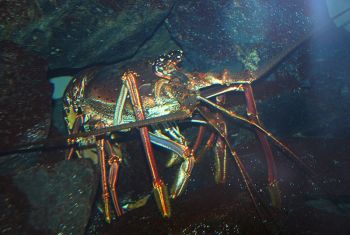Spiny Lobster
Category: Lobster

Facts about Spiny Lobster, "Scientific name for Spiny Lobster is Panulirus interruptus". The Spiny Lobster is one among the 60 varieties of achelate crustaceans, which comes from the Palinuridae family. The Spiny Lobster are also called as the Langouste Lobster or Rock lobsters, and the Spiny Lobster are largely found in New Zealand, Australia, The Bahamas and South Africa. Occasionally, these lobsters are also called as sea crayfish, crayfish, or craw-fish. The Spiny Lobster can be seen in approximately all warm oceans, as well as the Mediterranean Sea and the Caribbean Sea, but they are particularly widespread in South Africa and in Australasia, where they are commonly called as sea crayfish or crayfish. The Spiny lobster is safe to eat and they are an economically important food resource. The Spiny Lobster are the major food export of the Bahamas.
Features
The Spiny lobster can be easily differentiated from true lobsters through their elongated, thick, thorny antenna, through the lack of claws on the initial four pairs of walking legs. However, the female Spiny Lobsters boast a small claw on their fifth pair and by a principally focused larval stage called phyllosoma. True lobsters boast much smaller head and claws on their primary three pairs of legs, with the initial being mostly enlarged.
Characteristically, the Spiny lobster has a somewhat compressed carapace, missing any lateral edges. Their antenna is short of a scaphocerite, the compressed exopod of the antenna. This is combined to the epistome, which is a plate between the Spiny Lobster labrum and the basis of their antenna. The flagellum, over the antenna, is fat, tapering and extremely long. The ambulatory legs of the Spiny Lobster end in chelae or claws.
The Spiny Lobsters use to make rasping sounds to prevent predators. The sound is made by frictional vibrations through slipping and sticking, like rubber materials descending against hard surfaces. Though many insects employ frictional vibration mechanisms to make a sound, this particular audio mechanism of the Spiny Lobster is distinctive in the animal kingdom. Notably, the system does not count on the rigidity of the exoskeleton, as several other arthropod noises do, signifying that the the Spiny Lobsters can keep on to make the deterrent sounds even during the period after a molt while they are most susceptible.
Diet
The Spiny Lobster mostly feeds on clams, snails, sea urchins and crabs.
Behavior
Mostly, the Spiny Lobster prefers to live in coral reefs and crevices of rocks, only rarely venturing out at nighttime to look for food. Occasionally, the Spiny Lobster travel in extremely large groups in extended files of lobsters across the sea ground. The length of these lineups may be in excess of 50 lobsters. The Spiny Lobster navigate by making use of the smell and flavor of natural matter in the water that vary in dissimilar parts of the sea. They are also capable of navigating by detecting the magnetic field of the earth. The Spiny Lobster keep jointly in contact, using their elongated antenna. Prospective predators may be discouraged from eating these lobsters by a loud scream made by their antenna by rubbing against a soft part of their exoskeleton. Usually, the Spiny Lobsters show social habit by moving and living collectively. However, some healthy lobsters diverge from contaminated ones leaving the unhealthy lobsters to take care of themselves.
Image by Jarek Tuszynski / CC-BY-SA-3.0 & GDFL [CC BY-SA 3.0 (http://creativecommons.org/licenses/by-sa/3.0) or GFDL (http://www.gnu.org/copyleft/fdl.html)]

 Back To Category Lobster
Back To Category Lobster